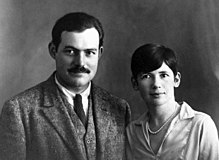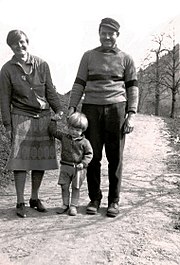Վիքիպեդիա:Նախագիծ:Թարգմանչի անկյուն/Անգլերեն/31
Էռնեստ Հեմինգուեյ
Անգլերեն
Փարիզ
Carlos Baker, Hemingway's first biographer, believes that while Anderson suggested Paris because "the monetary exchange rate" made it an inexpensive place to live, more importantly it was where "the most interesting people in the world" lived. In Paris, Hemingway met writers such as Gertrude Stein, James Joyce, and Ezra Pound who "could help a young writer up the rungs of a career". The Hemingway of the early Paris years was a "tall, handsome, muscular, broad-shouldered, brown-eyed, rosy-cheeked, square-jawed, soft-voiced young man." He and Hadley lived in a small walk-up at 74 rue du Cardinal Lemoine in the Latin Quarter, and he worked in a rented room in a nearby building. Stein, who was the bastion of modernism in Paris, became Hemingway's mentor and godmother to his son Jack; she introduced him to the expatriate artists and writers of the Montparnasse Quarter, whom she referred to as the "Lost Generation"—a term Hemingway popularized with the publication of The Sun Also Rises. A regular at Stein's salon, Hemingway met influential painters such as Pablo Picasso, Joan Miró, and Juan Gris. He eventually withdrew from Stein's influence and their relationship deteriorated into a literary quarrel that spanned decades. The American poet Ezra Pound met Hemingway by chance at Sylvia Beach's bookshop Shakespeare and Company in 1922. The two toured Italy in 1923 and lived on the same street in 1924. They forged a strong friendship, and in Hemingway, Pound recognized and fostered a young talent. Pound introduced Hemingway to the Irish writer James Joyce, with whom Hemingway frequently embarked on "alcoholic sprees".

During his first 20 months in Paris, Hemingway filed 88 stories for the Toronto Star newspaper. He covered the Greco-Turkish War, where he witnessed the burning of Smyrna, and wrote travel pieces such as "Tuna Fishing in Spain" and "Trout Fishing All Across Europe: Spain Has the Best, Then Germany". Hemingway was devastated on learning that Hadley had lost a suitcase filled with his manuscripts at the Gare de Lyon as she was traveling to Geneva to meet him in December 1922. The following September, the couple returned to Toronto, where their son John Hadley Nicanor was born on October 10, 1923. During their absence, Hemingway's first book, Three Stories and Ten Poems, was published. Two of the stories it contained were all that remained after the loss of the suitcase, and the third had been written the previous spring in Italy. Within months a second volume, in our time (without capitals), was published. The small volume included six vignettes and a dozen stories Hemingway had written the previous summer during his first visit to Spain, where he discovered the thrill of the corrida. He missed Paris, considered Toronto boring, and wanted to return to the life of a writer, rather than live the life of a journalist.
Hemingway, Hadley and their son (nicknamed Bumby) returned to Paris in January 1924 and moved into a new apartment on the rue Notre-Dame des Champs.[42] Hemingway helped Ford Madox Ford edit the The Transatlantic Review, which published works by Pound, John Dos Passos, Baroness Elsa von Freytag-Loringhoven, and Stein, as well as some of Hemingway's own early stories such as "Indian Camp". When In Our Time (with capital letters) was published in 1925, the dust jacket bore comments from Ford. "Indian Camp" received considerable praise; Ford saw it as an important early story by a young writer, and critics in the United States praised Hemingway for reinvigorating the short story genre with his crisp style and use of declarative sentences. Six months earlier, Hemingway had met F. Scott Fitzgerald, and the pair formed a friendship of "admiration and hostility". Fitzgerald had published The Great Gatsby the same year: Hemingway read it, liked it, and decided his next work had to be a novel.
With his wife Hadley, Hemingway first visited the Festival of San Fermín in Pamplona, Spain, in 1923, where he became fascinated by bullfighting. The Hemingways returned to Pamplona in 1924 and a third time in June 1925; that year they brought with them a group of American and British expatriates: Hemingway's Michigan boyhood friend Bill Smith, Donald Ogden Stewart, Lady Duff Twysden (recently divorced), her lover Pat Guthrie, and Harold Loeb. A few days after the fiesta ended, on his birthday (July 21), he began to write the draft of what would become The Sun Also Rises, finishing eight weeks later. A few months later, in December 1925, the Hemingways left to spend the winter in Schruns, Austria, where Hemingway began revising the manuscript extensively. Pauline Pfeiffer joined them in January and against Hadley's advice, urged Hemingway to sign a contract with Scribner's. He left Austria for a quick trip to New York to meet with the publishers, and on his return, during a stop in Paris, began an affair with Pauline, before returning to Schruns to finish the revisions in March. The manuscript arrived in New York in April; he corrected the final proof in Paris in August 1926, and Scribner's published the novel in October.

The Sun Also Rises epitomized the post-war expatriate generation, received good reviews, and is "recognized as Hemingway's greatest work". Hemingway himself later wrote to his editor Max Perkins that the "point of the book" was not so much about a generation being lost, but that "the earth abideth forever"; he believed the characters in The Sun Also Rises may have been "battered" but were not lost.
Hemingway's marriage to Hadley deteriorated as he was working on The Sun Also Rises. In the spring of 1926, Hadley became aware of his affair with Pauline Pfeiffer, who came to Pamplona with them that July. On their return to Paris, Hadley asked for a separation; in November she formally requested a divorce. They split their possessions while Hadley accepted Hemingway's offer of the proceeds from The Sun Also Rises. The couple were divorced in January 1927, and Hemingway married Pauline Pfeiffer in May.
Pfeiffer, who was from a wealthy Catholic Arkansas family, had moved to Paris to work for Vogue magazine. Before their marriage, Hemingway converted to Catholicism. They honeymooned in Le Grau-du-Roi, where he contracted anthrax, and he planned his next collection of short stories, Men Without Women, which was published in October 1927, and included his boxing story "Fifty Grand". Cosmopolitan magazine editor-in-chief Ray Long praised "Fifty Grand", calling it, "one of the best short stories that ever came to my hands...the best prize-fight story I ever read...a remarkable piece of realism."
By the end of the year Pauline, who was pregnant, wanted to move back to America. John Dos Passos recommended Key West, and they left Paris in March 1928. That spring, Hemingway suffered a severe injury in their Paris bathroom, when he pulled a skylight down on his head thinking he was pulling on a toilet chain. This left him with a prominent forehead scar, which he carried for the rest of his life. When Hemingway was asked about the scar, he was reluctant to answer. After his departure from Paris, Hemingway "never again lived in a big city".
| Թարգմանիչ | ||
| Վերստուգող |

